The Bay State may be small, but that doesn’t mean it’s not a powerhouse for birdwatching adventures. There are 12 finches you can spot here – most of them regular and a few accidental.
It’s fitting that one of America’s smallest states would be a prime place to spot one of the smallest bird species. I’ve been to Boston before and it’s an experience I’ll never forget – I plan on returning someday with some bird-watching goals in hand!
As you’re strolling through Massachusetts’ many idyllic small towns, keep an eye out for these passerine birds. We’ll help you learn how to spot these birds by their coloration, birdsong, and feeding habits.
House Finch
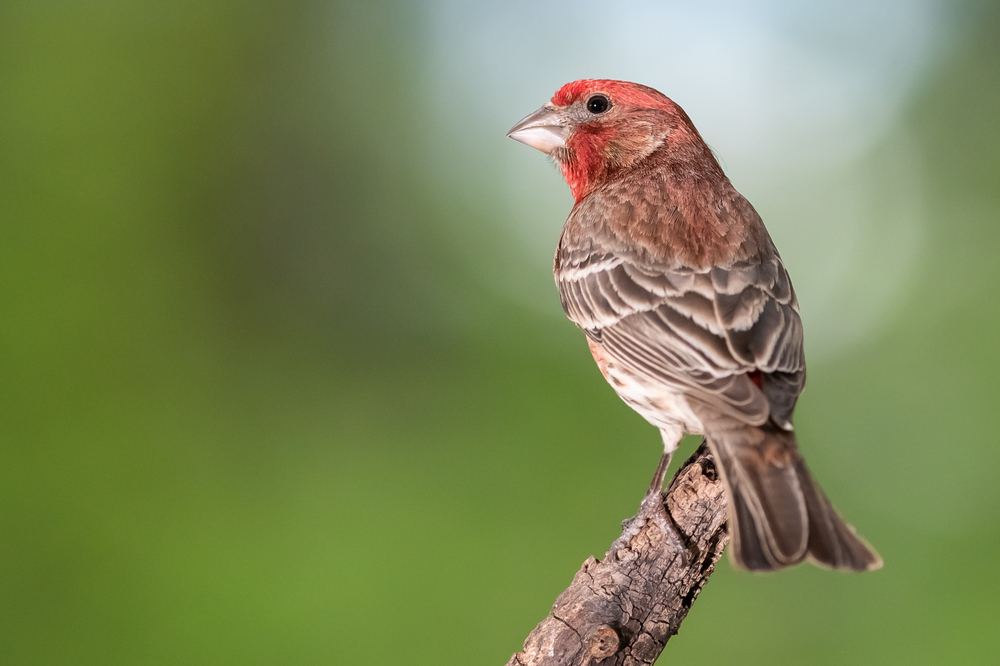
- Species Name: Haemorhous mexicanus
- Length: 13 cm to 14 cm
- Weight: 16 grams to 27 grams
- Wingspan: 20 to 25 cm
Let’s start off the list with the easiest of the finches to spot. The house finch appears in Massachusetts all year long and is comfortable in a wide variety of environments.
Appearance
House finches are hardy birds, but that doesn’t mean they can’t have some style. The male house finch has a sleek body with a red head and chest.
The female house finch has a similar body shape but has a speckled light gray and brown body.
Range
Massachusetts is a truly lovely state, filled with hiking and boating opportunities galore. No matter what kind of excursion you’re on, you’ll likely run into a house finch.
These social birds appear in people’s backyards, farms, gardens, forests, and parks. They don’t migrate and maintain a steady population for easy birdwatching sessions.
Diet
A major testament to house finches’ adaptability is their diverse diet. They eat a variety of flower buds, fruit, and seeds.
However, they definitely have a preference for seeds. If you want to attract house finches for a viewing or painting session, fill a tube or a platform feeder with black oil sunflower seeds.
These bird feeders are some of the most comfortable environments for their social flocks. As such, these are popular birds to watch eat, play, and groom.
Birdsong
House finches have a sweet song, warbling and twittering with occasional pauses. These songs often have a rise-fall-rise note in three successions, though they sometimes shake things up.
Fun Fact
Male house finches dazzle with a courtship display described as ‘butterfly flight’. This ritual involves flying to high altitudes, and then gliding back down while singing.
Common Chaffinch
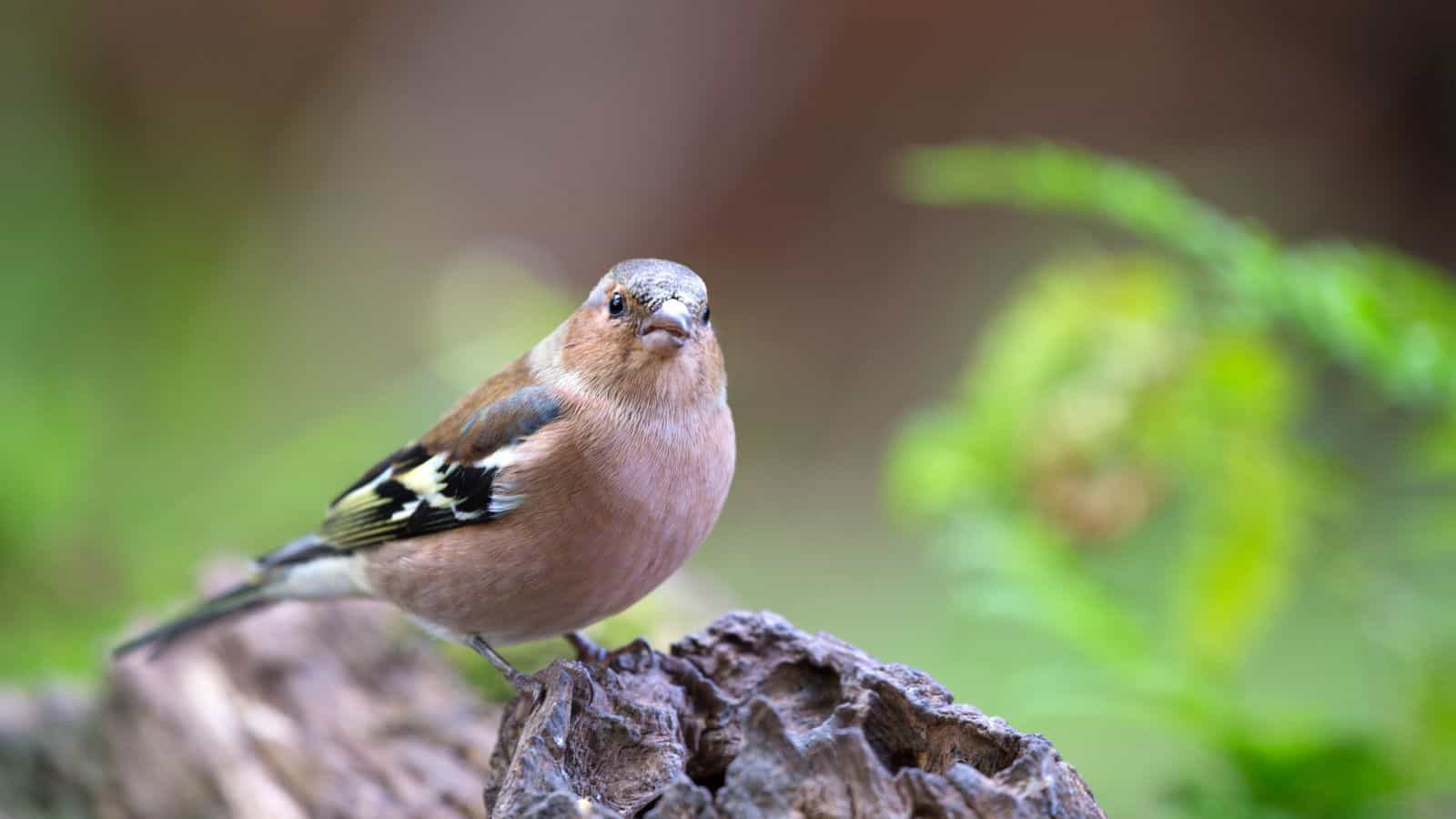
- Species Name: Fringilla coelebs
- Length: 14 cm
- Weight: 18 grams to 29 grams
- Wingspan: 24 to 28 cm
The common chaffinch is a finch I’m excited to paint soon. Their coloration is one of the most subtle and unique of the finch species.
Appearance
The male common chaffinch is a lesson in elegance, boasting a gray-blue head and a hazy orange body. Their wings are black with white wing bars.
Female common chaffinches share the same color scheme and pattern but are less saturated.
Range
While a rare sight in Massachusetts, you can definitely spot them with a little patience. They prefer to frequent forests and orchards where they can forage for food.
However, they’re not opposed to visiting a backyard or bustling park space if there’s enough to eat!
Diet
The common chaffinch switches up their diet depending on the season – they prefer insects in the summer and feast on seeds in the winter months.
Outfit your bird feeders with sunflower seeds or get a suet feeder when it gets cold. Common chaffinches won’t be able to resist such an easy meal.
Birdsong
The common chaffinch has a bold, rapid-fire song of chirps and tweets. Expect to hear a fast twee-twee-twee followed by swooping whistles.
Fun Fact
You know you’re a gorgeous bird when you go by many names. The common chaffinch also goes by the Eurasian chaffinch or simply chaffinch.
Brambling

- Species Name: Fringilla montifringilla
- Length: 16 cm
- Weight: 23 grams to 29 grams
- Wingspan: 25 to 26 grams
I intentionally put the brambling next on this list because of its similar appearance to the common chaffinch. These charming finches are quite lovely and have a few subtle differences you should know about.
Appearance
While the male brambling shares the common chaffinch’s color scheme, their heads are different. Bramblings often have speckled black and white heads, though they can be entirely black.
Female bramblings have similar coloration but lean toward brown and white body feathers instead of black.
Range
These colorful finches are rather rare in Massachusetts, though you may be able to spot one in more forested areas. Bramblings are fond of agricultural fields and parks, though they also visit birch tree woods.
Diet
Bramblings like to switch up their diet depending on the season, too – seeds in the winter and insects in the summertime. However, they sometimes dine on berries.
You may be able to entice the rare brambling to your yard with fresh sunflower seeds, so make a note for your winter checklists.
Birdsong
Their song is airy and subtle, composed of sparse cheeps and chirps with long pauses in between.
Fun Fact
Turns out bramblings aren’t just visually similar to chaffinches – they sometimes mingle with them during breeding seasons in massive flocks.
Purple Finch

- Species Name: Haemorhous purpureus
- Length: 12 cm to 16 cm
- Weight: 18 grams to 32 grams
- Wingspan: 22 cm to 26 cm
The purple finch is quite fond of the American coast, so it’s unsurprising they show up frequently in the Bay State. They regularly make themselves at home in Massachusetts’ brilliant evergreen forests.
Appearance
The male purple finch isn’t actually purple, but a vivid red. This rosy color transitions into a soft brown along their wings and white on their belly.
The female purple finch isn’t purple, either (but who’s counting). They have a sparrow-like appearance with a mottled brown and white body.
Range
If you feel like taking a forest trip, keep a close eye on the trees – purple finches love to forage for flower buds. They tend to show up more frequently during the early spring and fall.
Diet
Flower buds are a real treat for purple finches, but they also eat seeds, berries, and nectar.
This diverse diet means you can entice a few to your backyard with black oil sunflower seeds or millet.
Birdsong
The purple finch is a classic songbird, letting loose a delicate rising and falling warble that repeats consistently. It sounds a little like fwerdy-fwerdy-frr.
Fun Fact
These alluring finches have one more trick up their sleeve. During the winter, male purple finches will have more white along their feathers – this almost makes them look ‘dusted’ with snow.
Pine Siskin

- Species Name: Spinus Pinus
- Length: 11 cm to 14 cm
- Weight: 12 grams to 18 grams
- Wingspan: 18 cm to 22 cm
The tiny pine siskin is a regular sight in Massachusetts, though they prefer to show up in the winter. You won’t have trouble spotting them against the state’s many dark green pine trees.
Appearance
Male pine siskins are on the smaller side, boasting a brown and yellow streaked body with a pointed silhouette. Even their bills are a little thinner and shorter than most finches.
Female pine siskins are more subtle in their brown plumage and look similar to juveniles.
Range
Deciduous forests and evergreen forests are their favorite places to roam. Expect to see more of them in the early spring and late fall.
Diet
Pine siskins regularly flit in and around pine cones trying to find the perfect angle to grab a seed. They will occasionally take breaks to forage the ground for grass seeds.
Try attracting a few pine siskins to your yard with black oil sunflower or nyjer seeds. Keep in mind they’re a boisterous crowd, so don’t be surprised if they make quite a ruckus!
Birdsong
The pine siskin has an excitable song that sounds like a strained, trilling squeal. They will break this up with the occasional cheep or brisk warble.
Fun Fact
Occasionally pine siskins will boast a more vivid yellow coloration, almost making them appear like a different species. These types of finches will be quite appealing to bird watchers with a sharp eye.
Red Crossbill

- Species Name: Loxia curvirostra
- Length: 14 cm to 17 cm
- Weight: 40 grams
- Wingspan: 25 cm to 27 cm
This finch is one striking bird, due in no small part to its brilliant coloration. It also prefers to show up in the winter, which makes it stand out all the harder against its environment.
Appearance
The male red crossbill may make you think of a cardinal at a glance. They have vivid red feathers with a black band across the eyes, black wings, and white streaks.
The female red crossbill is a gentle olive green with speckles of gray, gray-brown, and white. Both males and females have characteristic beaks that cross over when closed, a unique trait among finches.
Range
Coniferous forests are the primary stomping grounds for red crossbills, but they sometimes drift over to explore mountain ranges. They’re also fond of visiting backyard feeders for a quick meal.
Diet
A fantastic trait of red crossbills is how diverse their diet is, making them a shoo-in for ‘easiest bird to feed’. While they usually dig around pine cones for food, you can attract them with millet, safflower seeds, or suet.
Birdsong
Red crossbills have a heaving rise-and-fall pattern to their warble.
Fun Fact
These sociable birds have a rather interesting mating ritual where they grab each other by their bills.
White-Winged Crossbill
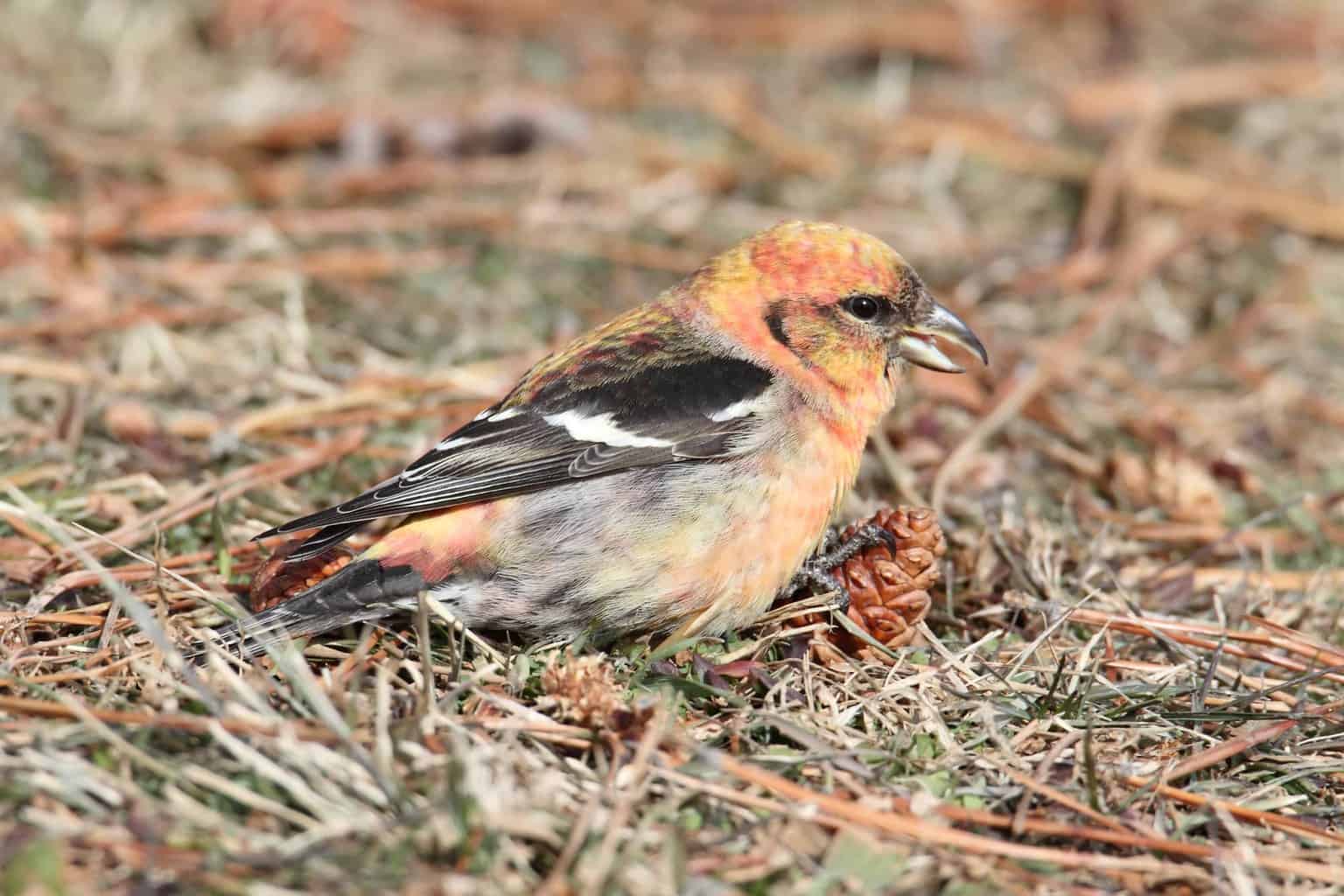
- Species Name: Loxia leucoptera
- Length: 15 cm to 17 cm
- Weight: 24 grams to 26 grams
- Wingspan: 26 cm to 28 cm
With a similar name and similar appearance, it’s easy to confuse the red crossbill with the white-winged crossbill. This finch is a great choice for birdwatchers who want a challenge.
Appearance
White-winged crossbills have vibrant red bodies with black wings and white spots. Unlike the red crossbill, their white wing bars are much larger.
The female white-winged crossbills are a soft yellow-brown with similar wings to the males. They both have crossed bills, an interesting trait compared to the usual conical seed-eating bill.
Range
White-winged crossbills usually linger around spruce forests. While you won’t spot them as often as other finches on this list, they usually show up in Massachusetts during the winter.
Diet
Their uniquely shaped bills help them dig into the gaps of cones to pull out seeds. As such, they usually prefer to forage over visiting feeders.
Fortunately, Massachusetts is a lovely location for a good nature walk, so keep an eye out!
Birdsong
Their song is an intense one, characterized by rapid-fire ri-ri-ri and chirps in succession.
Fun Fact
The white-winged crossbill sometimes goes by the name two-barred crossbill.
Evening Grosbeak

- Species Name: Hesperiphona vespertina
- Length: 16 cm to 22 cm
- Weight: 38 grams to 86 grams
- Wingspan: 30 cm to 60 cm
An indispensable addition to a Massachusetts vacation is glimpsing this brilliant finch. Their feather pattern is one of the more unique combinations seen in this species.
Appearance
Adult males have a bold yellow body with a black head and black wings. They have large white wing bars and a quirky yellow ‘browline’.
The female evening grosbeak has a soft gray body with black and white wings. If you look closely, you may spot a hint of yellow on her neck or throat.
Range
These finches roam far and wide, visiting mountain ranges as readily as forests. They usually show up in Massachusetts during the winter, particularly in December and January.
Diet
This bird is not one for monotony, eating insects during the summer and flowers in springtime. You can attract evening grosbeaks by understanding how they function in their normal winter range.
They prefer seeds during the colder months due to their higher oil content, so keep your feeder stocked with sunflower seeds. Watching these birds use their powerful beaks to break tough shells is incredibly satisfying.
Birdsong
Their song is a vibrating trill that also has a breathing in-and-out pattern. They’ll occasionally sprinkle in a few chirps or tweets.
Fun Fact
Evening grosbeak is quite a useful bird for reducing pest species that can harm trees.
Rose-Breasted Grosbeak
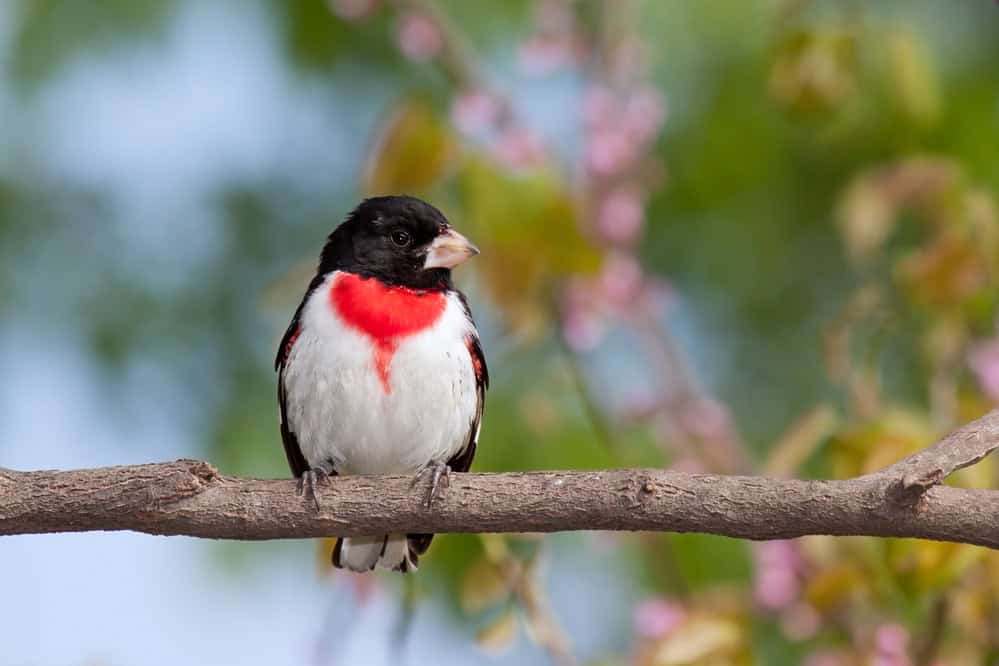
- Species Name: Pheucticus ludovicianus
- Length: 18 cm to 22 cm
- Weight: 35 grams to 65 grams
- Wingspan: 29 cm to 33 cm
This stocky finch is a charming sight in Massachusetts and one you don’t want to miss if you’re a photographer. They have an incredibly unique color scheme that stands out immediately.
Appearance
It’s no mystery how this finch got its name. Rose-breasted grosbeak males have a black head with a white chest splashed with red.
The female rose-breasted grosbeak has a yellow-olive body with a brown break and a white streak over their eyes.
Range
Deciduous forests with abundant trees are their preferred environments, though they often congregate around parks, forest edges, and gardens. They usually show up in Massachusetts during the breeding season, though it can overlap with their migration routes.
Diet
The rose-breasted grosbeak is a hearty eater of insects, berries, nectar, and seeds. They’re also seen eating peas, oats, and wheat.
Try attracting a few rose-breasted grosbeaks with a platform feeder filled with black oil sunflower seeds. These are some of their favorite foods because they get a ton of energy.
Birdsong
The rose-breasted grosbeak has an almost conversational song of a low, musical warble interspersed with squeaks.
Fun Fact
These birds are quite a sight to watch while feeding, swift enough to snatch insects in mid-flight.
Hoary Redpoll

- Species Name: Acanthis hornemanni
- Length: 12 cm to 14 cm
- Weight: 11 grams to 20 grams
- Wingspan: 22 cm to 23 cm
A hoary redpoll is a truly dashing sight. However, don’t forget a heavy jacket and a scarf – winter in Massachusetts is seriously intense.
Appearance
The male hoary redpoll is gorgeous with its gray and white body, boasting a characteristic red spot on its forehead. They also have a faint pink chest and smaller-than-average bill.
The female hoary redpoll looks quite similar but with far more streaks on its body. They also have no pink on their chest.
These chunky birds have a habit of fluffing up and looking like little balls.
Range
These beautiful birds usually prefer the open tundra, but they’ll sometimes seek out evergreen forests. They’re also known to travel to towns that have weedy fields or scrublands.
Diet
Alder seeds, birch seeds, and insects are their primary diet. You may be able to bring them to your backyard with nyjer or black oil sunflower seeds.
Birdsong
The hoary redpoll song is brisk and repetitive, composed of fast chit-chit-chits or chit-chits.
Fun Fact
The hoary redpoll looks quite similar to the common redpoll, making it a challenge even for experienced bird watchers. Speaking of which…
Common Redpoll

- Species Name: Acanthis flammea
- Length: 12 cm to 14 cm
- Weight: 11 grams to 20 grams
- Wingspan: 19 cm to 22 cm
The common redpoll looks similar to the hoary redpoll thanks to their red spots and pale bodies. However, I’ll help you spot the difference!
Appearance
The male common redpoll has a bold red spot on its head with browner bodies than the hoary redpoll. They also have a distinctive notched tail and very short bills.
The female common redpoll looks similar but lacks the pink chest. Both birds are more ‘streaky’ than their hoary counterparts, but don’t beat yourself up if you still get them confused.
Range
These finches range from weedy fields to forests but sometimes drift over to backyard bird feeders.
Diet
Vegetable matter and seeds are their foods of choice – think willow, alder, and birch buds. They do love an easy meal, though, so give them a break with some fresh nyjer seeds.
Birdsong
Their delicate birdsong is composed of three-note chirps, often sounding very soft compared to other finches.
Fun Fact
Common redpolls are unusual among finches for having such a small beak, almost making them sparrow-like at a glance.
American Goldfinch
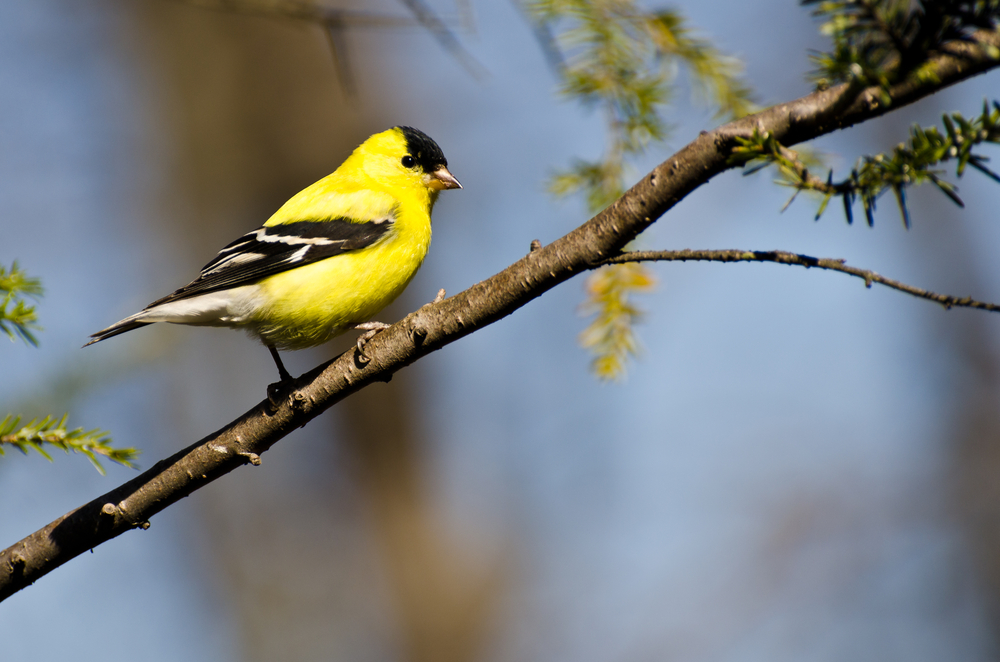
- Species Name: Spinus tristis
- Length: 11 cm to 14 cm
- Weight: 11 grams to 20 grams
- Wingspan: 19 cm to 22 cm
Let’s wrap up the list with this charming fellow. The American goldfinch may not be the state’s official bird, but it’d be a prime pick with its small size and adorable coloration.
Appearance
The male American goldfinch has a pale yellow body with a black spot on its head, black wings, and a black tail. They have yellow-orange beaks and legs.
Female American goldfinches are usually pale yellow with gray-black wings. This finch family contains one of the more diminutive finches.
Range
The more spacious an area, the more likely you’ll run into an American goldfinch. These birds adore weedy fields, meadows, and gardens.
They usually show up in the state year-round, so this is a great summer pick if you can’t stand East Coast winters.
Diet
While many finches eat insects, American goldfinches much prefer to eat seeds or grass. Try attracting them to your backyard with sunflower or nyjer seeds.
Birdsong
These beautiful finches put the ‘song’ in birdsong. The American goldfinch song has lilting and dynamic chirps, tweets, and rising twee-ee notes.
Fun Fact
The American goldfinch is a little unusual for molting twice in one year.
Don’t Forget Your Coat When Birdwatching in Massachusetts
Take it from me – you definitely don’t want to forget your winter gear when bird-watching in Massachusetts. Several of these finches prefer to show up during the winter, which gets freezing!
As long as you’re prepared, Massachusetts is a wonderful location to go on a nature walk or get a spectacular view of the ocean. If you’re feeling up for a summer trip, though, you’ll still be able to spot some house finches or bramblings.
Curious to learn more about the wildlife in this gorgeous state? We’ve got a guide on birds in Massachusetts to whet your appetite for your next trip.

